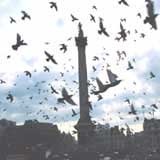 Digital Stock
Trafalgar Square seeks icon
Digital Stock
Trafalgar Square seeks icon
In a city as endlessly examined as London, you'd think more people would have noticed that Trafalgar Square—certainly a major tourist attraction—was, well, not quite finished. For 158 years, one of Trafalgar's four plinths (the large stone bases that form the corners of the square) has sat empty. The other three plinths are occupied by statues of King George IV on horseback and two long-forgotten Victorian generals, Sir Henry Havelock and Sir Charles James Napier. This month, however, all that will change—when the wonderfully named Vacant Plinth Advisory Group announces its selection of a permanent statue or work of art to fill the fourth space.
The VPAG, which was convened last summer, includes assorted chairs from leading arts organizations, a Cambridge University history professor, and, for some reason, the crime novelist Ruth Rendell. The group is now considering suggestions submitted by the British public; in the meantime the empty plinth has been occupied by a revolving series of temporary artworks. In March, a bronze head being crushed by a book (titled Regardless of History) replaced Ecce Homo, a lauded everyman sculpture of Jesus Christ.
As of March, some 550 votes had been cast. At last count, the queen was running ahead of Nelson Mandela and Princess Diana, was neck-and-neck with Captain James Cook, and (this could happen only in Britain) lagged behind a proposed tribute to "all animals killed in war."
Of course, a few critics worry about the decision's being left to the questionable aesthetic judgment of the "Great British Public." As a London journalist put it recently: "Since when has the GBP ever given a toss about art?"